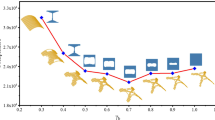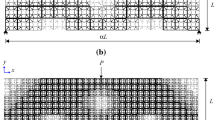Abstract
This paper introduces a purely heuristic topology optimization framework to improve specific energy absorption for thin-walled, extruded lattice structures. The framework optimizes the lattice cross section design by iteratively updating the lattice wall thicknesses. The main novelty of the work is the two novel thickness update schemes we proposed. The first update scheme is a direct statement of homogenization of wall-wise specific energy absorption, while the other scheme is based on the homogenization of a wall-wise sensitivity parameter inspired by the bi-directional evolutionary structural optimization method. Both schemes are based on the central idea of homogenization of certain field variables, which has been widely employed in previous optimization frameworks for thin-walled structures. The proposed framework has high potential because it can work directly with commercial finite element packages, and only requires information on the energy absorption of each element. Without the need for the finite element stiffness matrix, this framework can be used with explicit dynamics simulations to treat highly nonlinear problems. Three numerical examples are presented: (1) optimization of a column under axial compression, (2) optimization of a lattice-reinforced beam under dynamic three-point bending, and (3) optimization of a lattice-filled sandwich panel under blast loading. The results show that the framework can effectively increase specific energy absorption with as few as 25 nonlinear finite element simulations.
Graphical abstract










Similar content being viewed by others
References
Abramowicz W (2003) Thin-walled structures as impact energy absorbers. Thin-walled Struct 41(2–3):91–107
Abueidda DW, Kang Z, Koric S, James KA, Jasiuk IM (2021) Topology optimization for three-dimensional elastoplastic architected materials using a path-dependent adjoint method. Int J Numer Methods Eng 122(8):1889–1910
Alberdi R, Zhang G, Li L, Khandelwal K (2018) A unified framework for nonlinear path-dependent sensitivity analysis in topology optimization. Int J Numer Methods Eng 115(1):1–56
Alghamdi A, Downing D, Almalki Tino RA, Maconachie T, Lozanovski B, Brandt M, Qian M, Leary M (2021) Buckling phenomena in am lattice strut elements: A design tool applied to Ti-6Al-4V LB-PBF. Mater Des 208:109892
Avalle M, Chiandussi G, Belingardi G (2002) Design optimization by response surface methodology: application to crashworthiness design of vehicle structures. Struct Multidiscipl Optim 24(4):325–332
Barba D, Alabort C, Tang YT, Viscasillas MJ, Reed RC, Alabort E (2020) On the size and orientation effect in additive manufactured Ti-6Al-4V. Mater Des 186:108235
Baroutaji A, Sajjia M, Olabi A-G (2017) On the crashworthiness performance of thin-walled energy absorbers: recent advances and future developments. Thin-Walled Struct 118:137–163
Biegler LT, Zavala VM (2009) Large-scale nonlinear programming using ipopt: an integrating framework for enterprise-wide dynamic optimization. Comput Chem Eng 33(3):575–582
Byrd RH, Schnabel RB, Shultz GA (1987) A trust region algorithm for nonlinearly constrained optimization. SIAM J Numer Anal 24(5):1152–1170
Clausen A, Wang F, Jensen JS, Sigmund O, Lewis JA (2015) Topology optimized architectures with programmable Poisson’s ratio over large deformations. Adv Mater 27(37):5523–5527
Conn AR, Gould NIM, Toint PL (2000) Trust region methods. SIAM
Duddeck F, Hunkeler S, Lozano P, Wehrle E, Zeng D (2016) Topology optimization for crashworthiness of thin-walled structures under axial impact using hybrid cellular automata. Struct Multidisc Optim 54(3):415–428
Farrell PE, Ham DA, Funke SW, Rognes ME (2013) Automated derivation of the adjoint of high-level transient finite element programs. SIAM J Sci Comput 35(4):C369–C393
Forsberg J, Nilsson L (2007) Topology optimization in crashworthiness design. Struct Multidisc Optim 33(1):1–12
Frazier WE (2014) Metal additive manufacturing: a review. J Mater Eng Perform 23(6):1917–1928
Gao D, Li X, Chen H (2019) Application of improved particle swarm optimization in vehicle crashworthiness. Math Problems Eng 2019
Goel T, Roux W, Stander N (2009) A topology optimization tool for LS-Dyna users: LS-OPT/Topology. In: 7th European LS-Dyna conference, pp 14–15
Guangyong S, Guangyao L, Shujuan H, Shiwei Z, Wei L, Qing L (2010) Crashworthiness design for functionally graded foam-filled thin-walled structures. Mater Sci Eng A 527(7–8):1911–1919
Guo L, Tovar A, Penninger CL, Renaud JE (2011) Strain-based topology optimisation for crashworthiness using hybrid cellular automata. Int J Crashworth 16(3):239–252
Gurdal Z, Tatting B (2000) Cellular automata for design of truss structures with linear and nonlinear response. In: 41st Structures, Structural Dynamics, and Materials Conference and Exhibit, p 1580
He J, Kushwaha S, Abueidda D, Jasiuk I (2022) Exploring the structure-property relations of thin-walled, 2d extruded lattices using neural networks. arXiv preprint arXiv:2205.06761
Huang X, Xie YM (2007) Convergent and mesh-independent solutions for the bi-directional evolutionary structural optimization method. Finite Elements Anal Des 43(14):1039–1049
Huang X, Xie YM (2008) Optimal design of periodic structures using evolutionary topology optimization. Struct Multidisc Optim 36(6):597–606
Huang X, Xie YM, Lu G (2007) Topology optimization of energy-absorbing structures. Int J Crashworth 12(6):663–675. https://doi.org/10.1080/13588260701497862
Hunkeler S (2014) Topology Optimisation in Crashworthiness Design via Hybrid Cellular Automata for Thin Walled Structures. PhD thesis, Queen Mary University of London,
Hunkeler S, Duddeck F, Rayamajhi M (2013) Topology optimisation method for crashworthiness design using hybrid cellular automata and thin-walled ground structures. In 9th Europ LS-DYNA conf. Manchester
James KA, Waisman H (2015) Topology optimization of structures under variable loading using a damage superposition approach. Int J Numer Methods Eng 101(5):375–406
Jang HAH-H, Lee JY, Park GJ (2012) Dynamic response topology optimization in the time domain using equivalent static loads. AIAA J 50(1):226–234
Jie F, Liu Q, Liufu K, Deng Y, Fang J, Li Q (2019) Design of bionic-bamboo thin-walled structures for energy absorption. Thin-Walled Struct 135:400–413
Jung D, Gea HC (2004) Topology optimization of nonlinear structures. Finite Elements Anal Des 40(11):1417–1427
Kim H-S (2002) New extruded multi-cell aluminum profile for maximum crash energy absorption and weight efficiency. Thin-Walled Struct 40(4):311–327
Kurtaran H, Eskandarian A, Marzougui D, Bedewi NE (2002) Crashworthiness design optimization using successive response surface approximations. Comput Mech 29(4):409–421
Lee H-A, Park G-J (2015) Nonlinear dynamic response topology optimization using the equivalent static loads method. Comput Methods Appl Mech Eng 283:956–970
Leiva J (2004) Topometry optimization: a new capability to perform element by element sizing optimization of structures. In: 10th AIAA/ISSMO multidisciplinary analysis and optimization conference, pp 4595
Li L, Zhang G, Khandelwal K (2017) Topology optimization of energy absorbing structures with maximum damage constraint. Int J Numer Methods Eng 112(7):737–775
Liu T, Sun G, Fang J, Zhang J, Li Q (2019a) Topographical design of stiffener layout for plates against blast loading using a modified ant colony optimization algorithm. Struct Multidisc Optim 59(2):335–350
Liu K, Wu T, Detwiler D, Panchal J, Tovar A (2019b) Design for crashworthiness of categorical multimaterial structures using cluster analysis and Bayesian optimization. J Mech Des 141, 1 (12)
Liu J, Wang Y, Sun G, Pang T (2021) Multisurrogate-assisted ant colony optimization for expensive optimization problems with continuous and categorical variables. IEEE Trans Cybern 1:1
Maute K, Schwarz S, Ramm E (1998) Adaptive topology optimization of elastoplastic structures. Struct Optim 15(2):81–91
Murray YD (2007) User’s manual for LS-DYNA concrete material model 159. Report no. FHWA-HRT-05-062. USA: US Department of Transportation, Federal Highway Administration National Transportation Systems Center.
Ngoc SH, Guoxing L (2020) Thin-walled corrugated structures: a review of crashworthiness designs and energy absorption characteristics. Thin-Walled Struct 157:106995
Pauli V, Ralf G, Travis EO, Matt H, Tyler R, David C, Evgeni B, Pearu P, Warren W, Jonathan B, van der Walt SJ, Brett M, Wilson J, Millman KJ, Mayorov N, Nelson ARJ, Jones E, Kern R, Larson E, Carey CJ, Polat İ, Feng Y, Moore EW, VanderPlas J, Laxalde D, Perktold J, Cimrman R, Henriksen I, Quintero EA, Harris CR, Archibald AM, Ribeiro AH, Pedregosa F, van Mulbregt P (2020) SciPy 1.0 Contributors. SciPy 1.0. Fundamental Algorithms for Scientific Computing in Python. Nat Methods 17:261–272. https://doi.org/10.1038/s41592-019-0686-2
Phutela C, Aboulkhair NT, Tuck CJ, Ashcroft I (2019) The effects of feature sizes in selectively laser melted Ti-6Al-4V parts on the validity of optimised process parameters. Materials 13(1):117
Randers-Pehrson G, Bannister KA (1997) Airblast loading model for DYNA2D and DYNA3D. Technical report, Army research lab aberdeen proving Ground MD
Rozvany GIN (2009) A critical review of established methods of structural topology optimization. Struct Multidisc Optim 37(3):217–237
SIMULIA. Abaqus, (2020)
Sigmund O (2011) On the usefulness of non-gradient approaches in topology optimization. Struct Multidiscipl Optim 43(5):589–596
Soto CA, Diaz AR (1999) Basic models for topology design optimization in crashworthiness problems. In International Design Engineering Technical Conferences and Computers and Information in Engineering Conference, 19715, pp 1055–1064. American Society of Mechanical Engineers
Sun G, Fengxiang X, Li G, Li Q (2014) Crashing analysis and multiobjective optimization for thin-walled structures with functionally graded thickness. Int J Impact Eng 64:62–74
Suzhen W, Zheng G, Sun G, Liu Q, Li G, Li Q (2016) On design of multi-cell thin-wall structures for crashworthiness. Int J Impact Eng 88:102–117
Svanberg K (1987) The method of moving asymptotes-a new method for structural optimization. Int J Numer Methods Eng 24(2):359–373
Tsay JJ, Arora JS (1990) Nonlinear structural design sensivitity analysis for path dependent problems part 1: General theory. Comput Methods Appl Mech Eng 81(2):183–208
Tovar A, Patel NM, Niebur GL, Sen M, Renaud JE (2006) Topology optimization using a hybrid cellular automaton method with local control rules. J Mech Des 128(6):1205–1216. https://doi.org/10.1115/1.2336251
Verbart A, Langelaar M, van Keulen F (2016) Damage approach: a new method for topology optimization with local stress constraints. Struct Multidisc Optim 53(5):1081–1098
Wallin M, Jönsson V, Wingren E (2016) Topology optimization based on finite strain plasticity. Struct Multidisc Optim 54(4):783–793
Wang X, Shi J (2013) Validation of Johnson-Cook plasticity and damage model using impact experiment. Int J Impact Eng 60:67–75
Yang XY, Xie YM, Steven GP, Querin OM (1999) Bidirectional evolutionary method for stiffness optimization. AIAA J 37(11):1483–1488
Yin H, Wen G, Liu Z, Qing Q (2014) Crashworthiness optimization design for foam-filled multi-cell thin-walled structures. Thin-Walled Struct 75:8–17
Zarei HR, Kröger M (2007) Crashworthiness optimization of empty and filled aluminum crash boxes. Int J Crashworth 12(3):255–264
Zeng D, Duddeck F (2017) Improved hybrid cellular automata for crashworthiness optimization of thin-walled structures. Struct Multidisc Optim 56(1):101–115
Zhu G, Qiang Y, Zhao X, Wei L, Ho Chen (2020) Energy-absorbing mechanisms and crashworthiness design of cfrp multi-cell structures. Compos Struct 233:111631
Acknowledgements
We (I. J.) acknowledge the support of the Army Research Office contract (No. W 911NF-18-2-0067) and the National Science Foundation Grant (MOMS-1926353).
Author information
Authors and Affiliations
Contributions
JH: conceptualization, methodology, software, formal analysis, investigation, data curation, writing—original draft. SK: methodology, investigation, writing—original draft. DA: supervision, writing—review and editing. IJ: supervision, resources, writing—review and editing, funding acquisition.
Corresponding author
Ethics declarations
Conflict of interest
The authors declare that they have no conflict of interest.
Replication of results
The data and source code that support the findings of this study can be found at: https://github.com/Jasiuk-Research-Group/LatticeOPT.
Additional information
Responsible Editor: Makoto Ohsaki
Publisher's Note
Springer Nature remains neutral with regard to jurisdictional claims in published maps and institutional affiliations.
Rights and permissions
Springer Nature or its licensor holds exclusive rights to this article under a publishing agreement with the author(s) or other rightsholder(s); author self-archiving of the accepted manuscript version of this article is solely governed by the terms of such publishing agreement and applicable law.
About this article
Cite this article
He, J., Kushwaha, S., Abueidda, D. et al. LatticeOPT: a heuristic topology optimization framework for thin-walled, 2D extruded lattices. Struct Multidisc Optim 65, 308 (2022). https://doi.org/10.1007/s00158-022-03397-5
Received:
Revised:
Accepted:
Published:
DOI: https://doi.org/10.1007/s00158-022-03397-5




